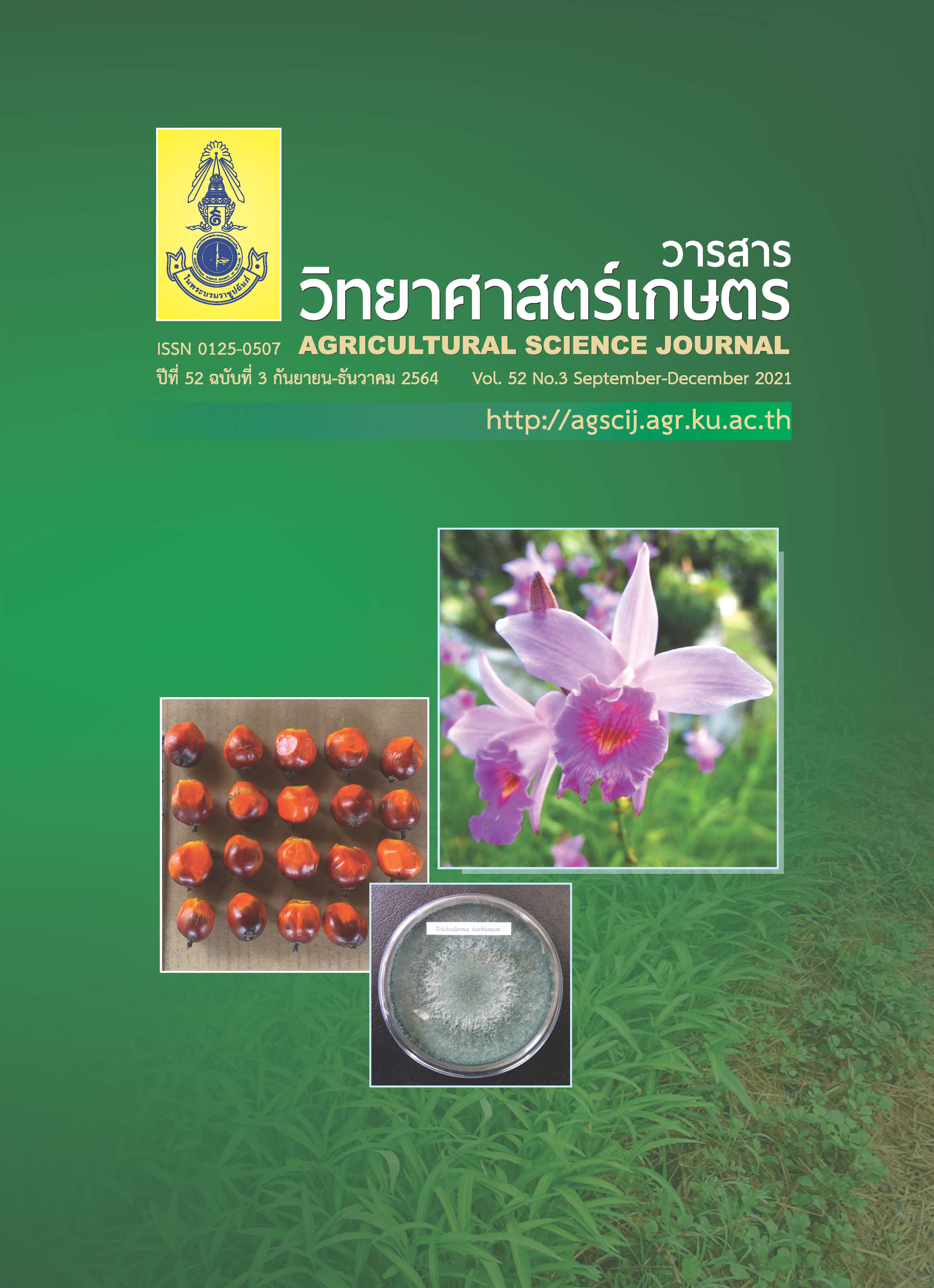ประสิทธิภาพของแสง LEDs ต่อการเจริญเติบโต สารต้านอนุมูลอิสระ และปริมาณสารประกอบฟีนอลิกของเอื้องใบไผ่ในสภาพปลอดเชื้อ
Main Article Content
บทคัดย่อ
เอื้องใบไผ่เป็นกล้วยไม้ดินที่มีสรรพคุณทางยา ในต่างประเทศมีการนำต้นที่ขึ้นในธรรมชาติมาใช้เป็นพืชสมุนไพร ดังนั้น การศึกษานี้จึงมีวัตถุประสงค์เพื่อเปรียบเทียบประสิทธิภาพของคุณภาพแสงในสภาพปลอดเชื้อที่แตกต่างกันต่อการเจริญเติบโต ฤทธิ์ต้านอนุมูลอิสระ และปริมาณสารประกอบฟีนอลิกของต้นกล้าเอื้องใบไผ่ โดยเลี้ยงต้นกล้าบนอาหารกึ่งแข็งสูตร Vacin and Went ดัดแปลง ร่วมกับการเติมน้ำตาล 10 กรัมต่อลิตร น้ำมะพร้าว 150 มิลลิลิตรต่อลิตร ผงถ่านกัมมันต์ 2 กรัมต่อลิตร กล้วยหอมบด 100 กรัมต่อลิตร และน้ำต้มมันฝรั่ง 100 กรัมต่อลิตร ภายใต้คุณภาพแสงต่างกัน วางแผนการทดลองแบบสุ่มสมบูรณ์ มี 5 ทรีตเมนต์ ได้แก่ แสง LEDs สีขาว สีแดง สีน้ำเงิน และสีแดงร่วมกับสีน้ำเงิน (1:1) และแสงฟลูออเรสเซนต์ (ชุดควบคุม) ทุกทรีตเมนต์ให้ความเข้มแสง 40 ไมโครโมลต่อตารางเมตรต่อวินาที เป็นเวลา 10 สัปดาห์ ผลการศึกษา พบว่า คุณภาพแสงส่งผลให้การเจริญเติบโต ฤทธิ์ต้านอนุมูลอิสระ และปริมาณสารประกอบฟีนอลิกรวมของต้นกล้าเอื้องใบไผ่แตกต่างกันทางสถิติ ยกเว้นความสูงต้น จำนวนใบ ความยาวใบ และความยาวราก โดยแสง LEDs สีขาวทำให้ต้นกล้าเอื้องใบไผ่มีน้ำหนักสด และปริมาณคลอโรฟิลล์รวมสูงที่สุด (1.30 กรัม และ 38.38 มิลลิกรัมต่อตารางเซนติเมตร ตามลำดับ) นอกจากนี้ แสง LEDs สีขาวยังช่วยกระตุ้นการสร้างฤทธิ์ต้านอนุมูลอิสระและสารประกอบฟีนอลิกรวมสูงที่สุด (EC50 72.17 gFW/L และ 1.39 mgGAE/gFW ตามลำดับ) ในขณะที่ แสง LEDs สีแดงร่วมกับสีน้ำเงิน (1:1) ทำให้ต้นมีเส้นผ่านศูนย์กลางลำต้นและความกว้างใบมากที่สุด (0.36 และ 0.45 เซนติเมตร ตามลำดับ) ดังนั้น แสง LEDs สีขาวจึงเป็นแนวทางในการเพิ่มสารประกอบเมตาโบไลต์ทุติยภูมิของต้นกล้าเอื้องใบไผ่ที่มีประโยชน์ทางเภสัชกรรม
Article Details
เอกสารอ้างอิง
Auberon, F., O.J. Olatunji, S. Krisa, C. Antheaume, G. Herbette, F. Bonté, J.M. Mérillon and A. Lobstein. 2016. Two new stilbenoids from the aerial parts of Arundina graminifolia (Orchidaceae). Molecules. 21(11): 1430.
Chand, M.B., M.R. Paudel and B. Pant. 2016. The antioxidant activity of selected wild orchids of Nepal. J. Coast. Life Med. 4(9): 731–736.
Debnath, B., D. Sarma, C. Paul and A. Debnath. 2016. Arundina graminifolia (D. Don) Hochr (Orchidaceae) a new addition to the flora of Tripura. Asian J. Plant Sci. Res. 6(3): 28–31.
Fan, X., J. Zang, Z. Xu, S. Gua, X. Jiao, X. Liu and Y. Gao. 2013. Effects of different light quality on growth, chlorophyll concentration and chlorophyll biosynthesis precursors of non–heading Chinese cabbage (Brassica campestris L.). Acta Physiol. Plant. 35: 2721–2726.
Ghosh, S., Y. Chisti and U.C. Banerjee. 2012. Production of shikimic acid. Biotechnol. Adv. 30(6): 1425–1431.
Hanus-Fajerska, E. and R. Wojciechowska. 2017. Impact of light–emitting diodes (LEDs) on propagation of orchids in tissue culture, pp. 305–320. In S. Dutta Gupta, ed. Light Emitting Diodes for Agriculture. Springer, Singapore.
Harbinson, J. and E. Rosenqvist. 2003. An introduction to chlorophyll fluorescence, pp. 1–29. In J.R. DeEll and P.M.A. Toivonen, eds. Practical Applications of Chlorophyll Fluorescence in Plant Biology. Springer, Boston, MA, USA.
Hebda, M.S., J. Kruk, M. Gorecka, B. Karpinska and S. Karpinski. 2010. Evidence for light wavelength–specific systemic photoelectron physiological signaling and cellular light memory of excess light episode in Arabidopsis. Plant Cell. 22: 2201–2218.
Hu, Q.F., B. Zhou, J.M. Huang, X.M. Gao, L.D. Shu, G.Y. Yang and C.T. Che. 2013. Antiviral phenolic compounds from Arundina gramnifolia. J. Nat. Prod. 76: 292–296.
Idris, S. and C.R.C.M. Zain. 2020. Modification of closed permanent immerse system to mass produce of Arundinar graminifolia by stem cutting. Int. J. Agric. For. Plant. 10: 13–17.
Ingkasupart, P., B. Manochai, W.T. Song and J.H. Hong. 2015. Antioxidant activities and lutein content of 11 marigold cultivars (Tagetes spp.) grown in Thailand. Food Sci. Technol., Campinas. 35(2): 380–385.
Kasemsap, P. 2020. Biology 2. Textbook of Science and Mathematics, The Promotion of Academic Olympiad and Development of Science Education Foundation under the Patronage of Her Royal Highness Princess Galyani Vadhana Krom Luang Naradhiwas Rajanagarindra. 7th edition. Darnsutha Press Co., Ltd., Bangkok, Thailand. (in Thai)
Lin, Y., J. Lie, B. Li, T. He and Z. Chun. 2011. Effects of light quality on growth and development of protocorm-like bodies of Dendrobium officinale in vitro. Plant Cell Tiss. Organ Cult. 105(3): 329–335.
Loi, M., A. Villani, F. Paciolla, G. Mulè and C. Paciolla. 2021. Challenges and opportunities of light-emitting diode (LED) as key to modulate antioxidant compounds in plants. Antioxidants. 10: 42.
Mengxi, L., X. Zhigang, Y. Yang and F. Yijie. 2011. Effects of different spectral lights on Oncidium PLBs induction, proliferation, and plant regeneration. Plant Cell Tiss. Organ Cult. 106: 1–10.
Müller, L., S. Gnoyke, A.M. Popken and V. Böhm. 2010. Antioxidant capacity and related parameters of different fruit formulations. LWT-Food Sci. Technol. 43(6): 992–999.
Ouzounis, T., E. Rosenqvist and C.O. Ottosen. 2015. Spectral effects of artificial light on plant physiology and secondary metabolism: a review. HortScience. 50(8): 1128–1135.
Porra, R.J., W.A. Thompson and P.E. Kriedemann. 1989. Determination of accurate extinction coefficients and simultaneous equations for assaying chlorophylls a and b extracted with four different solvents: verification of the concentration of chlorophyll standards by atomic absorption spectroscopy. Biochim. Biophys. Acta. 975(3): 384–394.
Qian, H., T. Liu, M. Deng, H. Miao, C. Cai, W. Shen and Q. Wang. 2016. Effects of light quality on main health-promoting compounds and antioxidant capacity of Chinese kale sprouts. Food Chem. 196: 1232–1238.
Re, R., N. Pellegrini, A. Proteggente, A. Pannala, M. Yang and C.R. Evans. 1999. Antioxidant activity applying an improved ABTS radical cation decolorization assay. Free Radic. Biol. Med. 26(9–10): 1231–1237.
Rojchana-umpawan, P. 2016. Species Diversity of Orchids in Ton Nga Chang Wildlife Sanctuary. MS Thesis, Prince of Songkla University, Songkla. (in Thai)
Suttasatain, N. 2019. Light Quality Affects In Vitro Growth of Arundina graminifolia (D. Don) Hochr. Plantlet. BS Special Problem, Kasetsart University, Bangkok. (in Thai)
Vacin, E.F. and F. Went. 1949. Some pH changes in nutrient solutions. Bot. Gaz. 110: 605–613.
Wang, W., M. Su, H. Li, B. Zeng, Q. Chang and Z. Lai. 2018. Effects of supplemental lighting with different light qualities on growth and secondary metabolite content of Anoectochilus roxburghii. Peer J. 6: e5274.
Wellburn, A.R. 1994. The spectral determination of chlorophylls a and b, as well as total carotenoids, using various solvents with spectrophotometers of different resolution. Plant Physiol. 144: 307–313.
Xu, Y. and P.J. Harvey. 2019. Carotenoid production by Dunaliella salina under red light. Antioxidants. 8(5): 123.
Yan, X., B. Tang and M. Liu. 2018. Phenanthrenes from Arundina graminifolia and in vitro evaluation of their antibacterial and anti-haemolytic properties. Nat. Prod. Res. 32(6): 707–710.
Yeow, L.C., B.L. Chew and S. Sreeramanan. 2020. Elevation of secondary metabolites production through light-emitting diodes (LEDs) illumination in protocorm-like bodies (PLBs) of Dendrobium hybrid orchid rich in phytochemicals with therapeutic effects. Biotechnol. Rep. 27: e00497.


